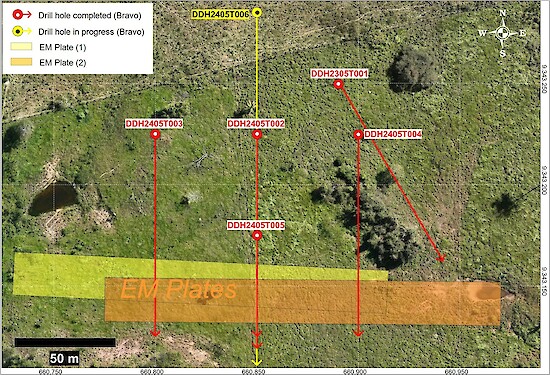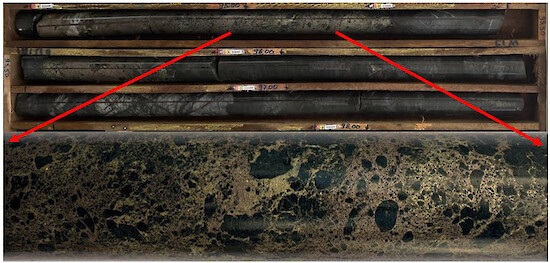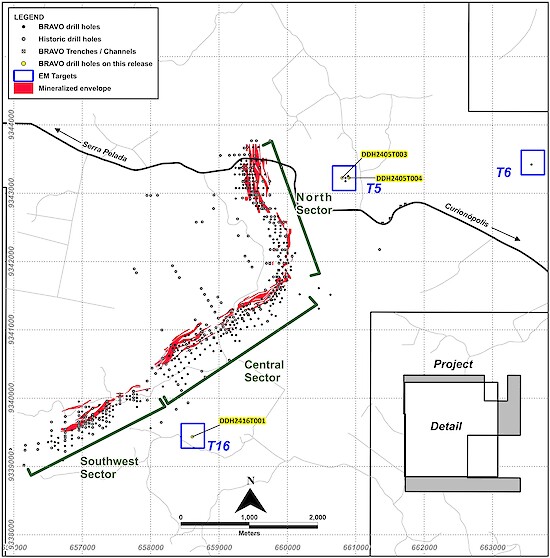Copper-Nickel Mineralization Intersected in First Drill Hole at T16 target
Intercept of 1.29m at 2.39% Cu, 1.17% Ni
VANCOUVER, June 10, 2024 – Bravo Mining Corp. (TSX.V: BRVO, OTCQX: BRVMF), (“Bravo” or the “Company”) has received assay results from the second drill hole at the “T5” target and from the first drill hole in the “T16” electromagnetic (“EM”) target. This is the third HeliTEM (Helicopter based electromagnetics) target to be drilled at the 100% owned Luanga Project (“Luanga”) which includes the Luanga palladium + platinum + rhodium + gold + nickel deposit (“Luanga Deposit”), in the Carajás Mineral Province, state of Pará, Brazil.
“Exploration continues to yield very encouraging results, both from ongoing drilling at T5, and now at another HeliTEM geophysical target, T16. At T5, we continue to intersect high-grade Iron Oxide Copper Gold style (“IOCG-style”) mineralization, which is a well documented style of mineralization in the Carajás, while at T6 and now T16, we potentially see two distinctly different styles of mineralization that appear magmatic related,” said Luis Azevedo, Chairman and CEO. “Whilst we are encouraged with these discoveries, we are still in the early days of the exploration program and these initial successes suggest potential for yet more discoveries given the number of anomalies Bravo has yet to test or follow up.” he said. “We also need to integrate these findings and new styles of mineralization into our regional models to reassess all the other HeliTEM anomalies that were previously set aside before we encountered IOCG-style mineralization at T5. The Carajás Mineral Province is an exceptionally fertile area and Luanga sits within a corridor containing several significant IOCG deposits/operations. Bravo looks forward to continuing our exploration efforts in this prolific region.”
Highlights Include:
- Hole DDH2405T004 at Target T5, located 50m east and along strike of previously reported high-grade hole DDH2405T002, intersected 8.75m of massive/semi-massive/breccia hosted high-grade copper sulphide mineralization grading 9.5% Cu and 2.1g/t Au (Figures 1 and 2).
- High-grade copper-gold mineralization at Target T5 remains open at depth and along strike.
- Hole DH2405T006 is now in progress at T5, below (down-dip of) discovery hole DH2405T002.
- Initial drill hole DDH2416T001 at Target T16 HeliTEM target intersected 1.29m of breccia hosted sulphide copper-nickel mineralization (Figure 5) grading 2.39% Cu, 1.17% Ni.
- Mineralization at T16 is potentially a different style of mineralization, one not previously observed at Luanga.
- Drilling will continue at T5, while a second drill rig will commence follow-up drilling on BHEM (Borehole Electromagnetic) anomalies at T6, T11, T15, T16 and T17.
- As a result of the initial positive results, the EM-target drilling has increased from an initial 3,000m to 8,000m and may increase further, depending on results.

Figure 1: 16% High-Grade Copper, 3.7g/t Gold in DDH2405T004 at T5 (161.5m downhole). Open along strike and at depth.
Exploration Drilling Update
Assay results have been received from diamond drill hole DDH2405T004 at the T5 target, 1km east of the Luanga Deposit, and from diamond drill hole DDH2416T001 at the T16 HeliTEM target, 1.2 km south of Luanga’s PGM+Au+Ni-rich Central Sector. BHEM has been completed on hole DDH2416T001 at T16. Together, this latest drilling comprises a total of 371 metres.
Bravo continues to conduct systematic first-pass drilling, coupled with BHEM, on the priority EM conductors identified by the HeliTEM survey. Although these modelled HeliTEM conductors have a lower degree of locational accuracy, they are sufficiently defined to position first-pass drilling proximal to the conductor’s location. From there, BHEM provides more precise location of EM anomalies for drill testing. Of the 17 priority EM anomalies identified in the HeliTEM survey (see press release September 11, 2023), Bravo has narrowed this list to 11 high priority conductors that warrant follow-up drilling of predominantly off-hole BHEM conductors. T5, T6 and now T16 are three of these 11 HeliTEM targets.
Drilling will continue at T5, while a second drill rig will commence to follow-up drilling on BHEM anomalies at T6, T11, T15, T16 and T17, before moving to new targets to implement initial drilling/BHEM.
T5 Target
Figure 2 shows the mineralization intersected in DDH2405T004, the second hole at the T5 target, and located 50m east and along strike of previously reported hole high-grade copper-gold mineralization in DDH2405T002 (see press release May 28, 2024) which intercepted 11.48m at 14.3% Cu, 3.3g/t Au including 2.9m at 22.9% Cu, 3.6g/t Au.

Figure 2: DDH2405T004 - Massive/Semi-massive/ breccia sulphide Cu mineralization at T5 target (154.0 – 161.4m shown).
Drill hole DDH2405T004 intersected 8.75m (grading 9.48% Cu, 2.1g/t Au) of massive/semi-massive/breccia hosted copper sulphide mineralization, at the T5 target. Like hole DDH2405T002, located 50m to the west, mineralization is interpreted to be consistent with typical Carajás IOCG-style hydrothermal mineralization (also supported by preliminary chemistry from handheld XRF spectrometer), further indicating T5 as IOCG-style and unrelated to the Luanga Deposit.
DDH2405T006 is now in progress, below (down-dip) DH2405T002, with additional drilling planned along strike and up and down dip.
| HOLE-ID | From (m) | To (m) | Thickness (m) | Cu (%) Sulphide | Ni* (%) Sulphide | Au (g/t) | TYPE |
|---|---|---|---|---|---|---|---|
| DDH2405T004 | 153.60 | 162.35 | 8.75 | 9.48 | 0.05 | 2.08 | FR |
Notes: All ‘From’, ‘To’ depths, and ‘Thicknesses’ are downhole.
As only one drill hole is present on the current three drill sections, the orientation true thickness of mineralization is currently unknown.
Type: FR = Fresh Rock. Recovery methods and results will differ based on the type of mineralization.
* Bravo’s Copper/nickel grades are sulphide, and do not include non-recoverable silicates.
Hole DH2405T003, drilled 50m west of DH2405T002 (Figure 4) intersected breccia hosted copper sulphides (Figure 3). Like DDH2405T002 and 004, this core also contains semi-massive/breccia IOCG-style copper sulphide mineralization, confirming continuity of the sulphide mineralization along strike. Assays are pending.

Figure 3: Breccia copper sulphides (results pending) in DH2405T003 (158.9 – 162.5m shown).
DH2405T005, located up dip of DH2405T002 (Figure 4), intersected oxidized mineralization with interpreted ex-massive sulphides present as weathered oxides (assays pending). Mineralization at T5 remains open along strike, and up-dip/down dip from the intercepts reported here.

Figure 4: Off-hole conductors at T5. Drill holes 002, 003 and 004 intersect conductor; 006 is in progress.
T16 Target
T16 is located 1km south of the PGM+Au+Ni mineralization in the Central Sector and is hosted in meta-diorite below the Luanga footwall ultramafic sequence. Figure 5 shows the intersected mineralization, which consists of 1.3m of breccia hosted sulphides, mainly pyrrhotite, generating a strong EM response. This first drill hole at T16 targets the HeliTEM anomaly and appears to have successfully intersected the EM conductor. BHEM data indicates that the conductor extends at depth, below DDH2416T001.
T16 has a clear association between Ni-Cu and Pt-Pd-Au, which is very different to both T5, which is essentially chalcopyrite (Cu sulphide) associated, and T6, which is essentially pyrrhotite (Fe sulphide) associated. This Pt-Pd-Au association indicates that T16 may have a contribution from the Luanga Deposit. The low Ni/Cu ratio (~0.5) and Au/Pd ratio (~0.75) are quite distinct from both magmatic and remobilized sulphides previously seen associated with the Luanga Deposit. Mineralization at T16 is potentially a different style of mineralization not previously observed at Luanga.
Follow-up drilling will target the BHEM conductor at a greater depth, below DDH2416T001.

Figure 5: DDH2416T001 breccia sulphide mineralization at T16 target (94.5 – 98.4m shown (top). Close-up at 95.0m).
| HOLE-ID | From (m) | To (m) | Thickness (m) | Cu (%) Sulphide | Ni* (%) Sulphide | Pd (g/t) | Au (g/t) | TYPE |
|---|---|---|---|---|---|---|---|---|
| DDH2416T001 | 94.59 | 95.88 | 1.29 | 2.39 | 1.17 | 0.16 | 0.10 | FR |
Notes: All ‘From’, ‘To’ depths, and ‘Thicknesses’ are downhole.
As only one drill hole is present on the current three drill sections, the orientation true thickness of mineralization is currently unknown.
Type: FR = Fresh Rock. Recovery methods and results will differ based on the type of mineralization.
* Bravo’s Copper/nickel grades are sulphide, and do not include non-recoverable silicates.
Drill Results Status Update
A total of 298 drill holes have been completed to date by Bravo, for 63,672 metres, including 8 metallurgical holes (not subject to routine assaying). Results have been reported for 249 Bravo drill holes to date. Assay results for 41 Bravo drill holes that have been completed are currently outstanding (excluding the metallurgical holes). Bravo plans to extend the current EM drilling program from 3,000m to 8,000m, to follow up identified EM anomalies, continue to systematically evaluate T5, and other high-priority conductors defined by HeliTEM and subsequent BHEM surveys. In addition to exploratory drilling on EM anomalies, ongoing drilling continues at the Luanga Deposit.
Complete Table of Recent Intercepts.
| HOLE-ID | Target | From (m) | To (m) | Thickness (m) | Cu (%) Sulphide | Ni* (%) Sulphide | Pd (g/t) | Au (g/t) | TYPE |
|---|---|---|---|---|---|---|---|---|---|
| DDH2405T004 | T5 | 153.60 | 162.35 | 8.75 | 9.48 | 0.05 | - | 2.08 | FR |
| DDH2416T001 | T16 | 94.59 | 95.88 | 1.29 | 2.39 | 1.27 | 0.16 | 0.10 | FR |
Notes: All ‘From’, ‘To’ depths, and ‘Thicknesses’ are downhole.
As only one drill hole is present on the current three drill sections, the orientation true thickness of mineralization is currently unknown.
Type: FR = Fresh Rock. Recovery methods and results will differ based on the type of mineralization.
* Bravo’s Copper/nickel grades are sulphide, and do not include non-recoverable silicates.

Figure 6: Location of Bravo Drilling at the T5 and T16 targets, reported in this News Release
About Bravo Mining Corp.
Bravo is a Canadian and Brazil-based mineral exploration and development company focused on advancing its Luanga Project in the world-class Carajás Mineral Province of Brazil
Bravo is the most active explorer in Carajás. The team, comprising local and international geologists, has a proven track record of PGM, nickel, and copper discoveries in the region. They have successfully taken a past IOCG greenfield project from resource definition to development and production in Carajás.
The Luanga Project is situated on mature freehold farming land and benefits from being in a location close to operating mines and a mining-experienced workforce, with excellent access and proximity to existing infrastructure, including road, rail, and clean renewable hydro grid power. A fully funded 63,000m infill, step out and exploration drilling and trenching program is well advanced for 2024. Bravo’s current Environmental, Social and Governance activities includes planting more than 18,000 high-value trees in the project area, hiring and contracting locally, and ensuring protection of the environment during its exploration activities.
Technical Disclosure
Technical information in this news release has been reviewed and approved by Simon Mottram, F.AusIMM (Fellow Australia Institute of Mining and Metallurgy), President of Bravo Mining Corp. who serves as the Company’s “qualified person” as defined in National Instrument 43-101 Standards of Disclosure for Mineral Projects (“NI 43-101”). Mr. Mottram has verified the technical data and opinions contained in this news release.
For further information about Bravo, please visit www.bravomining.com or contact:
Luis Azevedo, Chairman and CEO or
Alex Penha, EVP Corporate Development
T: +1-416-509-0583
info@bravomining.com
Neither TSX Venture Exchange nor its Regulation Services Provider (as that term is defined in policies of the TSX Venture Exchange) accepts responsibility for the adequacy or accuracy of this release.
Forward Looking Statements
This news release contains forward-looking information which is not comprised of historical facts. Forward-looking information is characterized by words such as “high-grade”, “encouraging”, “exceptionally”, “positive results”, “priority”, “continuity significant”, “discovery”, “strong EM response”, variants of these words and other similar words, phrases, or statements that certain events or conditions “may” or “will” occur. This news release contains forward-looking information pertaining to the Company’s ongoing drill program and the results thereof; the potential for new and/or different styles of mineralization in some areas, such as IOCG-style, the presence of which is publicly well documented in the Carajás mineral province; whether or not the mineralization interested at T5 is in fact IOCG-style, some variant of such or another style of mineralization; the potential continuity of mineralization between holes; the grades and implications of unassayed holes; the visual and XRF identification of minerals in the core; whether the other anomalies are related to mineralization; and the Company’s plans in respect thereof. Forward-looking information involves risks, uncertainties and other factors that could cause actual events, results, and opportunities to differ materially from those expressed or implied by such forward-looking information. Factors that could cause actual results to differ materially from such forward-looking information include, but are not limited to, unexpected results from exploration programs, changes in the state of equity and debt markets, fluctuations in commodity prices, delays in obtaining required regulatory or governmental approvals, environmental risks, limitations on insurance coverage; and other risks and uncertainties involved in the mineral exploration and development industry. Forward-looking information in this news release is based on the opinions and assumptions of management considered reasonable as of the date hereof, including, but not limited to, the assumption that the assay results confirm that the interpreted along strike and up and down dip; that activities will not be adversely disrupted or impeded by regulatory, political, community, economic, environmental and/or healthy and safety risks; that the Luanga Project will not be materially affected by potential supply chain disruptions; and general business and economic conditions will not change in a materially adverse manner. Although the Company believes that the assumptions and factors used in preparing the forward-looking information in this news release are reasonable, undue reliance should not be placed on such information. The Company disclaims any intention or obligation to update or revise any forward-looking information, other than as required by applicable securities laws.
Schedule 1: Drill Hole Collar Details
| HOLE-ID | Company | East (m) | North (m) | RL (m) | Datum | Depth (m) | Azimuth | Dip | Area |
|---|---|---|---|---|---|---|---|---|---|
| DDH2405T003 | Bravo | 660800.010 | 9343224.570 | 195.120 | SIRGAS2000_UTM_22S | 180.20 | 180.00 | -60.00 | T5 EM Target |
| DDH2405T004 | Bravo | 660899.990 | 9343224.690 | 185.840 | SIRGAS2000_UTM_22S | 200.35 | 180.00 | -60.00 | T5 EM Target |
| DDH2405T005 | Bravo | 660850.000 | 9343175.020 | 194.850 | SIRGAS2000_UTM_22S | 125.05 | 180.00 | -60.00 | T5 EM Target |
| DDH2416T001 | Bravo | 658609.925 | 9339435.185 | 192.545 | SIRGAS2000_UTM_22S | 170.45 | 330.00 | -60.00 | T16 EM Target |
Schedule 2: Assay Methodologies and QAQC
Samples follow a chain of custody between collection, processing, and delivery to the SGS Geosol laboratory in Parauapebas, state of Pará, Brazil. The drill core is delivered to the core shack at Bravo’s Luanga site facilities and processed by geologists who insert certified reference materials, blanks, and duplicates into the sampling sequence. Drill core is half cut and placed in secured polyurethane bags, then in security-sealed sacks before being delivered directly from the Luanga site facilities to the Parauapebas SGS Geosol laboratory by Bravo staff. Additional information about the methodology can be found on the SGS Geosol website (SGS) in their analytical guides. Information regarding preparation and analysis of historic drill core is also presented in the table below, where the information is known.
Quality Assurance and Quality Control (“QAQC”) is maintained internally at the lab through rigorous use of internal certified reference materials, blanks, and duplicates. An additional QAQC program is administered by Bravo using certified reference materials, duplicate samples and blank samples that are blindly inserted into the sample batch. If a QAQC sample returns an unacceptable value an investigation into the results is triggered and when deemed necessary, the samples that were tested in the batch with the failed QAQC sample are re-tested.
| Bravo SGS Geosol | ||||
|---|---|---|---|---|
| Preparation | Method | Method | Method | Method |
| For All Elements | Pt, Pd, Au | Rh | Sulphide Ni, Cu | Trace Elements |
| PRPCLI (85% at 200#) | FAI515, FAI34V | FAI30V | AA04B | ICP40B |
